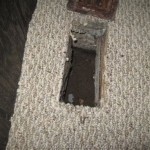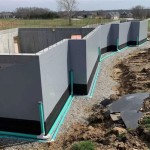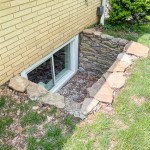How To Put Drain Tile In Basement
Water leakage in the basement is a common problem that can cause significant damage to your home. One of the most effective ways to prevent water from entering your basement is to install a drain tile system. A drain tile system is a network of perforated pipes that are buried around the perimeter of your basement. When water seeps into the ground, it is collected by the drain tile and directed away from your home.
Installing a drain tile system is a relatively simple process, but it is important to do it correctly in order to ensure that it is effective. Here are the steps on how to put drain tile in basement:
1. Determine the layout of your drain tile system
The first step is to determine the layout of your drain tile system. You will need to decide where you want the drain tile to be installed, as well as how deep you want it to be buried. The depth of the drain tile will depend on the depth of your basement floor. You will also need to decide where you want the drain tile to discharge the water. The discharge point can be a sump pump, a storm drain, or a dry well.
2. Excavate the trench for the drain tile
Once you have determined the layout of your drain tile system, you will need to excavate the trench for the drain tile. The trench should be at least 4 inches wide and 12 inches deep. The bottom of the trench should be sloped so that the water will flow towards the discharge point.
3. Install the drain tile
Once the trench is excavated, you can begin installing the drain tile. The drain tile should be laid in the trench with the perforations facing down. The drain tile should be spaced about 12 inches apart. You can use a gravel bed to support the drain tile and to prevent it from clogging.
4. Connect the drain tile to the discharge point
Once the drain tile is installed, you will need to connect it to the discharge point. The discharge point can be a sump pump, a storm drain, or a dry well. If you are connecting the drain tile to a sump pump, you will need to install a check valve to prevent water from flowing back into the drain tile.
5. Backfill the trench
Once the drain tile is connected to the discharge point, you can backfill the trench. The trench should be backfilled with gravel or crushed stone. The gravel or crushed stone will help to keep the drain tile in place and to prevent it from clogging.
6. Test the drain tile system
Once the drain tile system is installed, you should test it to make sure that it is working properly. To test the drain tile system, you can pour water into the trench. The water should flow towards the discharge point and should not back up into the trench.
Conclusion
Installing a drain tile system is a relatively simple process, but it is important to do it correctly in order to ensure that it is effective. By following these steps, you can install a drain tile system that will help to keep your basement dry and free from water damage.

Basement Drainage Drying A Wet Diy Family Handyman

Basement Drain Tile Installation In Your Home Beltsville Md Aquaguard Waterproofing

Drain Tile System Installation Drainage Culvert Pipe French Catch Basin Covers

Basement Repair Waterproofing Concrete Leveling In Michigan

Drain Tile Can Save Your Basement American Dry

Top 5 Star Basement Interior Drain Tile System Solutions

What Is Drain Tile Epp Foundation Repair

Remedial Drainage Options Waterproof Magazine

Drain Tile Milwaee Zablocki Waterproofing

Drain Tile Systems Offer Ultimate Water Protection For Your Home
See Also








